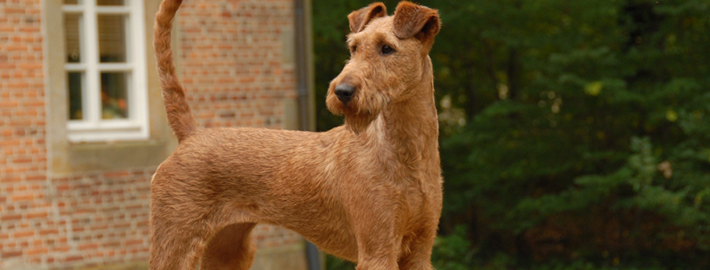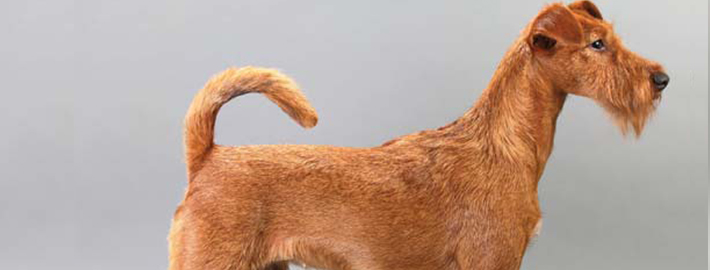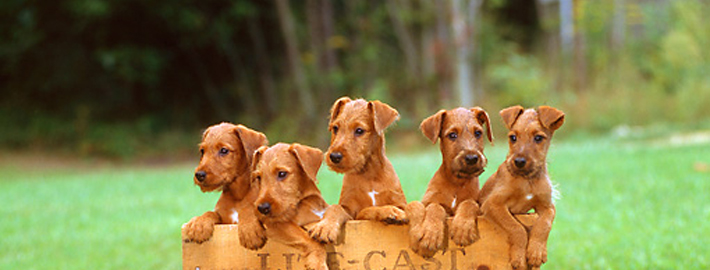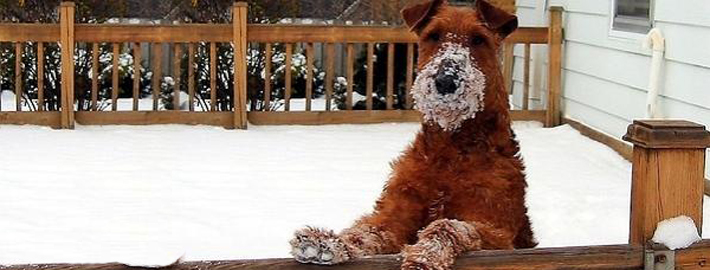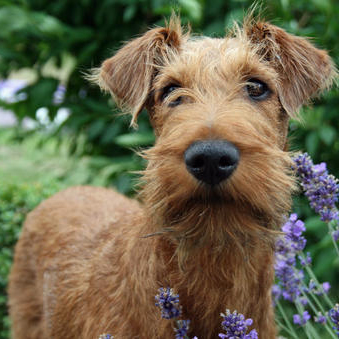What makes the Irish Terrier Unique?
The Irish Terrier dog breed was once described as the “poor man’s sentinel, the farmer’s friend, and the gentleman’s favorite.” Rugged and stouthearted, he has the advantages of a convenient size, versatile abilities as a companion, watchdog, and vermin dispatcher, and high trainability.
Breed Groups
Page Contents
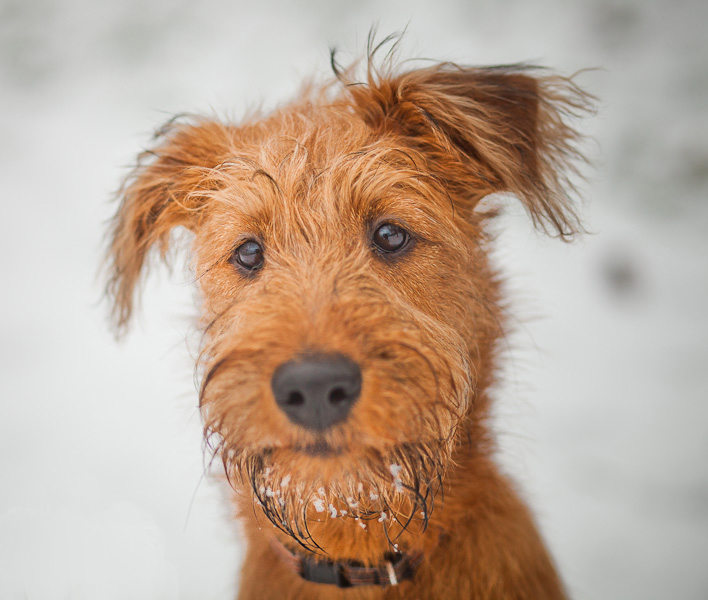
SnapShot
| Size: | Males – 46 to 51 cm (18 to 20 inches) Females – 46 to 51 cm (18 to 20 inches) |
| Weight: | Males – 11 to 12 kg (25 to 27 pounds) Females – 11 to 12 kg (25 to 27 pounds) |
| Origin: | Ireland |
| Life Span: | 12 – 15 Years |
| Colour: | Bright Red, Golden Red, Red Wheaten, or Wheaten (pale yellow or fawn) |
| Litter Size: | 7 to 8 puppies |
Is the Irish Terrier Right For You?
Irish Terriers are good with people. They have a highly developed sense of loyalty and it is important that they have a strong responsible leader, for whom they have natural respect. Most Irish Terriers love children and tolerate rough-housing to a certain extent. Irish terriers need exercise; do not get one if you are not prepared to walk it. They enjoy training, new tasks are easily mastered with food and toys working equally well as motivation.
The Irish Terrier will do okay in an apartment if it is sufficiently exercised; a small yard will do. If given sufficient exercise, it is surprisingly well-mannered and dignified indoors.
In 5 Words
- Good-tempered
- Spirited
- Alert
- Adaptable
- Devoted
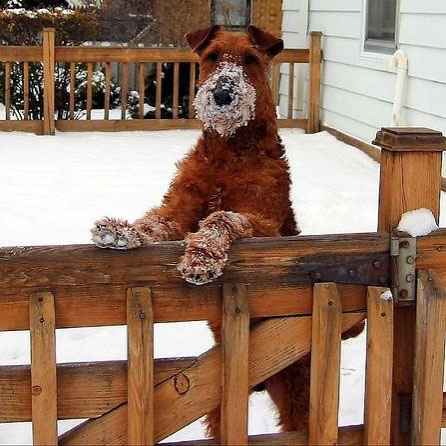
Characteristics
Learn About the Irish Terrier
Description
General Description
The Irish Terrier is a medium-sized dog that is somewhat longer than it is tall. The long head is flat between the ears and is in good proportion to the rest of the body. It has a slight stop that is not very noticeable unless you view the dog from the side. The nose is black. The teeth meet in a scissors or level bite. The small eyes are dark brown with bushy eyebrows. The ears are V-shaped, fold forward toward the outside corners of the eyes, and have darker, shorter hairs than the rest of the body. The ears of an Irish Terrier sometimes require “training.” The ears get glued to the top of their heads so that they form the correct shape as the cartilage fills in. Not all dogs require this, and it’s definitely not necessary if you’re not going to show the dog. A special non-toxic leather glue called tear-mender is used. The front legs are straight, long and muscular. The tail is docked taking off about 1/4th the natural length. Note: docking tails is illegal in most parts of Europe. The thick, rough-looking, wiry coat lies close to the body and comes in solid bright red, golden red, red wheaten, or wheaten. The coat has a softer undercoat. The dog has long whiskers and a bearded muzzle, sometimes with a small patch of white on the chest. Puppies are sometimes born black, but later change colors.
Short History of the Irish Terrier
The breed’s origin is not known. It is believed to have descended from the black and tan terrier-type dogs of Britain and Ireland, just like the Kerry Blue and Irish Soft-haired Wheaten Terriers in Ireland or the Welsh, Lakeland and Scottish Terriers in Great Britain.
F. M. Jowett writes in The Irish Terrier, ‘Our Dogs’ Publishing Co. Ltd., Manchester, England 1947 – 7th Edition: They are described by an old Irish writer as being the poor man’s sentinel, the farmer’s friend, and the gentleman’s favourite…These dogs were originally bred not so much for their looks as for their working qualities and gameness, the Irish Terrier being by instinct a thorough vermin killer. They were formerly of all types and of all colours – black-and-tan, grey-and-brindle, wheaten of all shades, and red being the predominant colours. Colour or size evidently did not matter if they were hardy and game.”
Temperament
The Irish Terrier was created to be a companion, guard dog, and hunter. As such, he’s good-tempered, spirited, alert, and adaptable. He’s also plucky, reckless, curious, and devoted. Those things all sound wonderful, and they are, but those characteristics aren’t always easy to live with. This is an independent, smart, strong-willed dog who’s scrappy with other dogs. He needs mental challenges in the form of training and play, physical exercise, and loving but firm discipline. On the plus side, Irish Terriers love people and are often friendly toward strangers. They’re not a one-person dog.
Caring for Your Irish Terrier
General Health
The Irish Terrier is a healthy breed and doesn’t have any common health problems. If you’re buying a puppy, find a good breeder who will show you health clearances for both your puppy’s parents. Health clearances prove that a dog has been tested for and cleared of a particular condition. In Irish Terriers, you should expect to see health clearances from the Orthopedic Foundation for Animals (OFA) for hip dysplasia (with a score of fair or better), elbow dysplasia, hypothyroidism, and von Willebrand’s disease; from Auburn University for thrombopathia; and from the Canine Eye Registry Foundation (CERF) certifying that eyes are normal. You can confirm health clearances by checking the OFA web site (offa.org).
Grooming & Bathing
The hard double coat is easy to groom and rarely sheds. Brush regularly with a stiff bristle brush and remove the dead hair with a fine-tooth comb. Bathe only when necessary. Irish Terriers are also supposed to be hand-stripped/ hand-plucked twice a year (just like an Airedale). Dogs that compete in dog shows need more extensive grooming.
Exercise & Training
The energetic Irish Terrier needs moderate exercise. Give him two or three walks on leash of 20 to 30 minutes each day. A chance to romp in a safely fenced area is also welcome. He’s not a true running breed, but he’s a good companion for joggers who go at an easy to moderate pace. He’s not a distance runner or a fast-paced dog. Condition him gradually, and wait until he’s fully grown before you start jogging with him.

